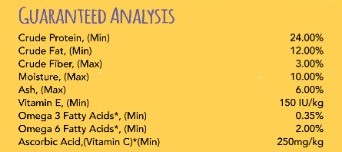
the scientific study of pet nutrition by veterinary nutrition specialists and experts.
All About Ash

We’ve previously discussed the Guaranteed Analysis on a pet food label, which includes the percentages as fed of protein, fat, fiber, and moisture as minimums (protein, fat) and maximums (fiber, moisture) in the food. These 4 nutrients are required to be on every pet food label; however, manufacturers can also add other nutrients to their guarantees (see the label pictures below) if they want to emphasize specific nutrients. One nutrient that is sometimes included in the Guaranteed Analysis is “ash” and this term tends to confuse or concern many pet owners!
 Simple Guaranteed Analysis with only required nutrients listed
Simple Guaranteed Analysis with only required nutrients listed
 More complex Guaranteed Analysis with ash listed
More complex Guaranteed Analysis with ash listed
When ash shows up on the Guaranteed Analysis, one of the most common questions that veterinarians are asked is “why would they put ash in my pet’s food?”. This is a very reasonable question that stems from the fact that the definition of “ash” in the food industry is a bit different than the definition with which most consumers are familiar.
When ash is used related to animal foods, it means minerals – calcium, phosphorus, iron, copper, zinc, etc. Ash is a crude measurement of the total amounts of minerals in a diet. It’s called ash because of how it is determined. Samples of feed are put into a furnace and then burned until they reach a constant weight. This means that the only thing left is elements that won’t burn, namely minerals. All organic materials such as fat, protein, fiber, and vitamins have been completely burned away. So, ash isn’t added to food, it’s what is left when everything else burns away during analysis; it is just one way to measure minerals in a diet.
Measuring ash is less complex and less expensive than measuring individual minerals and it can provide a rough estimate of the amount of mineral present in a diet. In this manner, ash is used to estimate the amount of carbohydrate in a diet, as this nutrient is not measured directly. Otherwise, ash isn’t valuable to know unless the actual amounts of individual minerals are not available, either because the manufacturer hasn’t measured them or won’t provide this information – both of which should raise a red flag!
As the majority of the minerals in a pet food are calcium and phosphorus, the % ash roughly parallels the amount of calcium and phosphorus in a diet. Dry pet foods, especially those that contain higher protein concentrations and more meat meals in the ingredient list, are usually higher in ash than canned foods. Fresh or frozen cooked foods are often lower in ash and raw diets can vary dramatically depending on the amount of included bone. As long as a diet meets the AAFCO nutrient profiles for the species and lifestage or has passed animal feeding trials, and the manufacturer is reputable, you can rest assured that the total amounts of minerals are appropriate for that lifestage.
For pets with medical conditions that may benefit from a diet higher or lower in specific minerals, actual amounts of the minerals of interest should be obtained from the diet manufacturer and all diet decisions based on average or typical concentrations of individual minerals rather than the ash. For example, large breed puppies are sensitive to excess calcium in their diet. While a high ash often indicates a higher calcium diet, it’s much more accurate to assess the calcium concentration in the diet directly to ensure that it is within safe ranges for large breed puppy growth. Another example would be a cat with heart disease that may benefit from a low sodium diet. As sodium is present in diets in smaller amounts than calcium and phosphorus, the ash provides little indication of whether a diet will have appropriate sodium concentrations.
Bottom line: If you see ash listed on the Guaranteed Analysis of a pet food label, take comfort that it is not anything unhealthy. It’s just a way of measuring included minerals, not a specific addition to a pet food. The % ash isn’t meant to provide consumers with any particularly useful information. If your veterinarian has advised you that your pet would benefit from a diet higher or lower in specific minerals, work with them to find a diet that meets their specific criteria for those individual mineral(s) and that will be readily accepted by your pet.
Feature image by Deadhouse from Pixabay
Want to read more information on feeding your pet?
Subscribe to always know when we add new material!
Recommended Posts

Can Diet Help With My Dog’s Seizures?
January 18, 2024

The Most Popular Holiday Foods…That Your Pet Should Avoid!
December 08, 2023

Veterinarian Recommended Pet Foods: What You Need to Know
November 05, 2023

